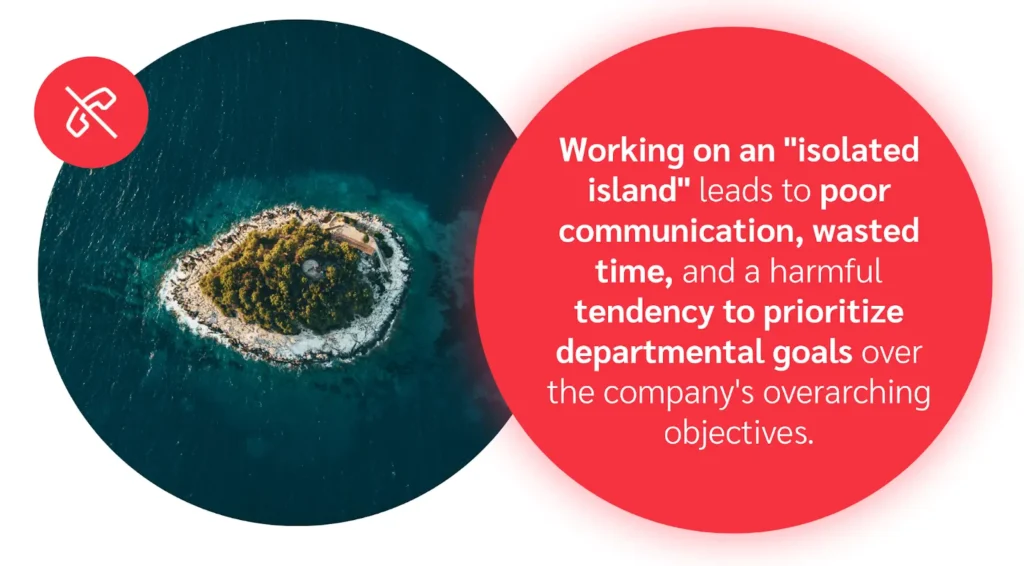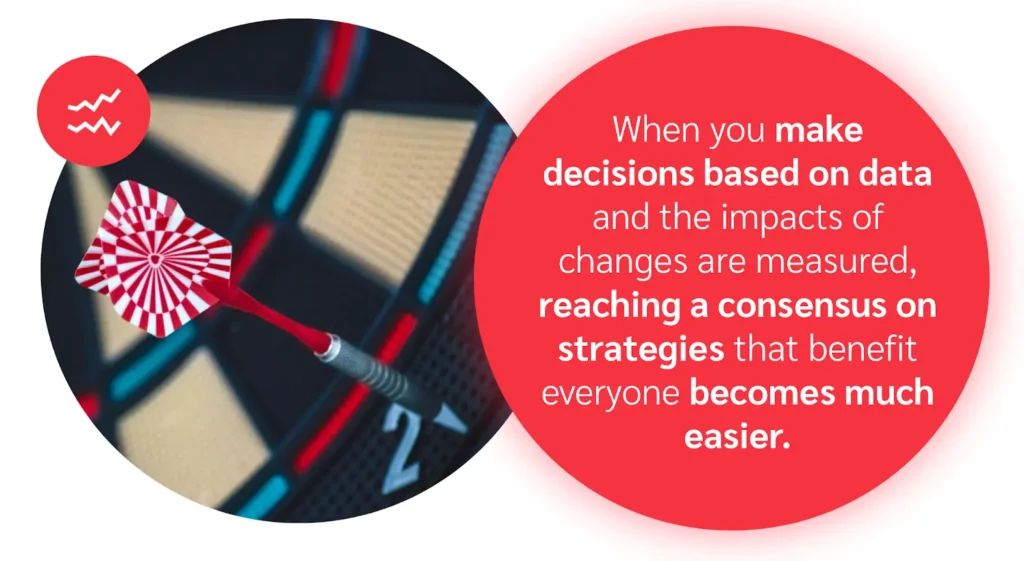Over three-quarters of marketers say silos make strategy alignment difficult. Considering 83 percent of companies reporting silos, this common issue can diminish the success of marketing leaders everywhere.
The silo mentality can manifest in many ways, from fragmented strategies to inconsistent messaging, which undermine your brand’s market presence. Marketers must address this problem to cultivate a unified approach that resonates with consumers and drives lasting results.
Discover how silos can undermine your efforts and explore effective ways to foster collaboration within your team and with external partners.
How the silo mentality harms marketing teams
The silo mentality is a harmful organizational issue where departments or individuals work in isolation, failing to share important information and collaborate with other teams.
Working on an “isolated island” leads to poor communication, wasted time, and a harmful tendency to prioritize departmental goals over the company’s overarching objectives. This mindset hinders team effectiveness by stifling the exchange of ideas and resources. Many marketing departments struggle with breaking down silos between marketing and sales teams.

However, the silo mentality isn’t limited to cross-departmental collaboration. Marketers can also silo themselves from external partners, such as agencies, influencers, or major publishers.
Silos result in campaigns that lack unity and focus, miss valuable opportunities, and struggle to achieve goals.
Luckily, you can overcome the silo mentality. By building a culture of teamwork and unity, marketing teams can boost their collective effectiveness, resulting in greater impact and success.
During an iPX 2024 session about breaking down silos, Sam Kimmel explains Hello Sunshine’s challenges with departmental divides and how closer collaboration led to a stand-out partnership with Taco Bell.
3 key strategies marketers can use to break down silos for good
Marketers must adopt targeted strategies that foster collaboration and communication to combat the detrimental effects of the silo mentality. By implementing specific approaches, marketers can break down both internal silos within their teams and external barriers with partners.
1. Cultivate a culture of curiosity
By fostering curiosity, employees can gain visibility into different facets of the business to better understand the bigger picture and work efficiently with different teams.
Marketing leaders can start by encouraging open dialogue and hosting regular brainstorming sessions. Set aside time regularly for teams to discuss ideas, ask questions, and share insights.
You can achieve this through structured meetings, workshops, or informal gatherings where everyone has a chance to speak. This creates an environment where curiosity is not just welcomed but celebrated.
Take a similar approach with external partners. Treat them like thought partners—not just service providers. Carve out brainstorming time to tap into their expertise and ask meaningful questions. This approach transforms your partners into important innovation sources aligned with the company’s goals.

Standing up mentorship programs that pair seasoned employees with newer ones can also be beneficial. Mentors can expand their mentees’ horizons, showing them how to ask the right questions and explore areas beyond their expertise.
Also, consider jumpstarting cross-department projects. This allows the marketing team to learn about other parts of the business and better understand how their roles connect. Long-term, they’ll adopt a more comprehensive approach to their work.
Members of the iPX 2024 panel about breaking down silos discuss the essential role of curiosity when it comes to working cross-functionally and growing your career as a marketer.
2. Look to data for guidance
When you make decisions based on data and the impacts of changes are measured, reaching a consensus on strategies that benefit all becomes much easier.
Begin by defining and establishing shared KPIs reflecting the organization’s goals. This approach has several benefits:
- Knowing how your work contributes can motivate more active involvement and accountability
- Setting data-driven goals eliminates subjectivity, making it easier to collaborate without getting stuck in individual viewpoints
- Achieving shared objectives reinforces a sense of accomplishment and unity
Share relevant KPIs with external partners and make it clear how they contribute. A shared focus on performance metrics sets clear expectations and lets your partners make informed decisions based on real-time insights.

Next, adopt unified analytics platforms that integrate data across various channels and departments. Marketers can gain a more holistic view of performance by centralizing metrics from social media, email campaigns, website performance, sales, and more.
If consolidating all your analytics in one location isn’t feasible, consistently exchanging relevant data will promote complete transparency among all involved. This transparency allows teams to evaluate strategies collaboratively, pinpoint areas for improvement, and drive collective accountability. It also promotes informed decision-making and helps diminish the ‘us vs. them’ mentality.
Hello Sunshine’s Sam Kimmel and Helen of Troy’s Jennifer Kim discussed ways to build convincing, data-driven cases to support your ideas during a talk about breaking down silos at iPX 2024.
3. Establish robust feedback loops
Ensuring that information flows freely within and outside your organization keeps everyone updated, engaged, and directed toward shared goals.
The first step is to schedule regular cross-functional meetings for sharing updates, discussing challenges, and celebrating triumphs. These meetings must invite perspectives from various department representatives.
This also extends to external partners. Even if they appear self-sufficient, book regular check-ins to share information and assess how projects are progressing.

After completing projects, encourage teams to conduct retrospectives where they can evaluate what worked and what didn’t. This encourages continuous improvement so all teams can be agile and responsive to challenges.
Solicit feedback from external partners routinely. Understanding their perspectives informs better collaboration while strengthening relationships. It also helps you identify areas of improvement that you might not have yet to consider.
Disney Streaming’s Elisa Charbonnel dives into the company’s strategy for establishing feedback loops with their partners at an iPX 2024 discussion about best-in-class affiliate programs.
Finally, leadership is key in establishing feedback loops and breaking down silos. Marketing leaders must lead by example, demonstrating open-mindedness, a willingness to listen, and a desire to collaborate.
This sets a tone for open communication and transparency, solidifying an anti-silo company culture.

Rally behind common goals to maximize marketing successes
Marketers can break down collaboration barriers by fostering a culture of curiosity, using data-driven methods, and creating strong feedback loops. These strategies improve communication and empower teams to work towards shared goals, leading to better performance and a clearer brand message.
Marketing leaders should prioritize these initiatives to create an environment where cross-functional teamwork flourishes, ensuring every team member and partner works toward overarching goals.
Discover more methods to enhance the effectiveness of your marketing efforts:
- From full funnel to full circle: 5 ways marketers can adapt to the new digital marketing funnel (blog)
- 3 must-have marketing programs for building community around your brand (blog)
- The ultimate guide to partnership marketing: Achieve exponential growth and exceptional customer experiences (blog)
FAQS
Marketing silos are isolated groups within an organization that work independently, often neglecting to share information or collaborate with other teams. This often leads to inconsistent messaging, missed opportunities, and inefficient use of resources.
Marketers need to address these silos because they undermine the effectiveness of campaigns and disrupt the alignment of the strategies necessary to reach common goals.
The silo mentality often starts at the leadership level, where departmental priorities can overshadow broader organizational goals. For example, marketing teams may focus solely on their campaigns without considering how they align with sales or product development.
Lack of cross-department training and communication can lead teams to believe they have separate objectives. This fragmentation stifles collaboration, resulting in inefficiencies and a disjointed approach to solving problems.
To break down silos in marketing, take a few key steps:
- Foster a culture of curiosity through brainstorming and mentorship
- Take a data-driven approach to cross-functional projects by establishing KPIs, aligning teams with shared objectives, and reducing subjectivity
- Create robust feedback loops through cross-functional meetings to promote transparent communication and continuous improvement.
Implementing these strategies enhances collaboration and maximizes the effectiveness of marketing initiatives.




